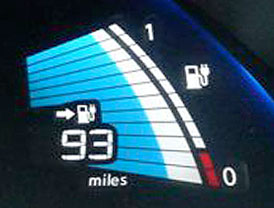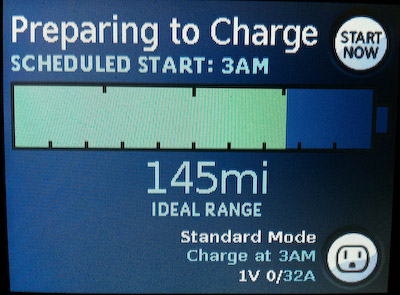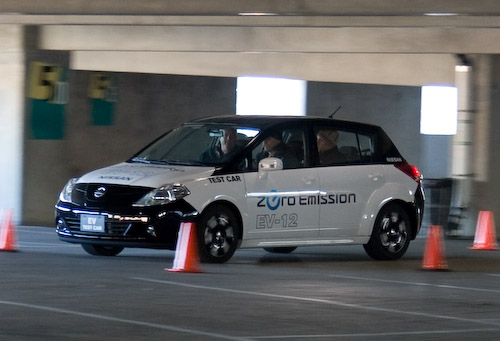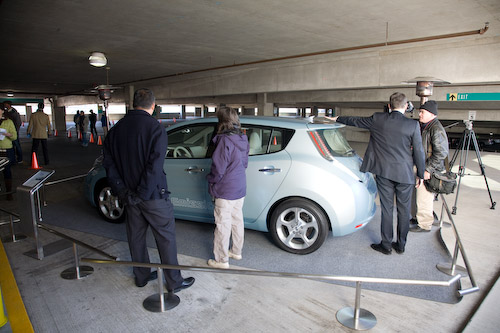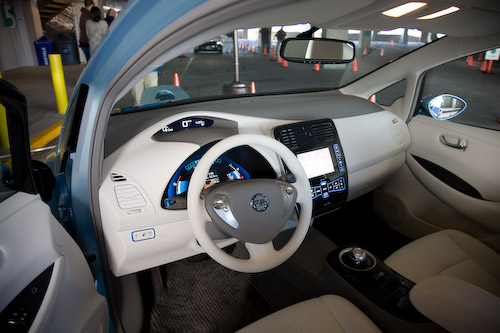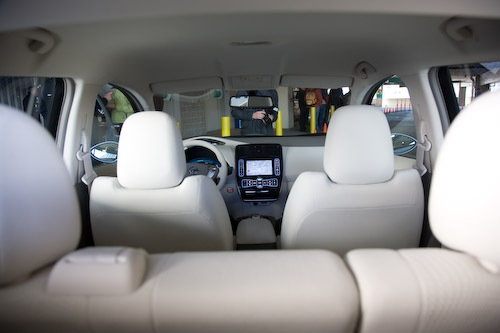updated 9/6/2011 2:42 pm: added nerdy charge graph
Last week, Cathy and I took the Roadster for a car show and week of island hopping through Washington's San Juan Islands and Vancouver Island in British Columbia. It was a lovely trip and unique in our EV road trip experiences in that we did the entire 450-mile trip using only 120V charging.
We are frequently asked where we charge our electric cars. The question is often accompanied by a pained expression that tries to offer sympathy for the sacrifice we make by driving electric. The answer is: mostly at home. People are frequently surprised to learn we have found it to be more convenient than going to a gas station.
Occasionally, we take a trip that requires charging on the road. That generally requires planning and finding electric vehicle charging stations. For this trip, there were some charging stations available, but they turned out to be both overpriced and unnecessary. We had chosen B&Bs that would allow us to charge from normal household outlets. On one island this was a big help as there were two otherwise equivalent choices: one that wanted to charge us $20 to use $1.60 worth of electricity and another that said we could do it for free. We gave our business to the one that didn't think we were incapable of doing math. Since we were taking a leisurely tour, and mostly on small islands, overnight charging at 120V was plenty for our daily driving needs.
The convenience of being able to fuel up from any outlet became especially apparent when we drove past this gas station in Sooke, BC.

We were on our way to Port Renfrew, some 45 miles further west along the southern coast of Vancouver Island. Had we been in a gas car, this would have been our last chance to gas up before our return, some 90 miles for the roundtrip plus any side excursions. Because we were in an electric car, and outlets are far more common than gas stations, we didn't care.
At Port Renfrew, we were going to be staying in a yurt at the Soule Creek Lodge. We'd contacted them in advance and knew they had an outlet we could use to charge the car. Charging at 120V only yields about 3 to 5 miles of range per hour of charging, which is painfully slow if you are waiting while you charge, but totally adequate if you're sleeping through it.

Our one night there, we picked up 53 miles of range, which was plenty to get us through the next day's driving.
My only regret for the trip was not getting a photo at Wildwood Manor on San Juan Island where we had deer grazing next to our charging car. Somehow you just never see deer grazing at a gas station.
Nerdy Charge Graph
Here's a graph of our state of charge for the trip. It shows the car's range in standard mode ideal miles, which means we can go that many miles at 55 to 60 mph on the highway, with another 25 miles in reserve.
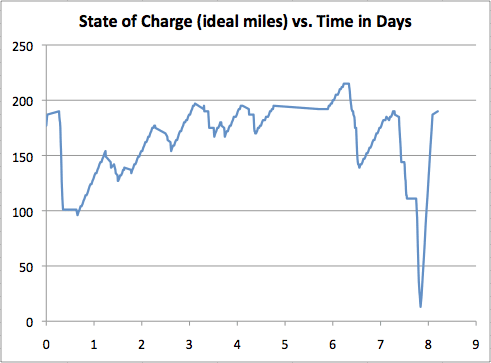 The first steep dive is the 90-mile drive to Anacortes, WA, to catch the ferry. Then there's a flat spot while we wait five hours after missing the cut-off for the unexpectedly popular first ferry by 5 minutes. Over the next three nights, we charged up overnight on Lopez and San Juan islands working back to a full standard mode (90%) charge, then a fourth charge returned us to full again. There are also a couple of little afternoon charges in there. The fifth charge is in Victoria, BC, after which the car stayed parked for a full day, then we did a range mode charge prior to departing for Port Renfrew. The overnight at Soule Creek Lodge got us back up to the top of standard mode (about 190 ideal miles). Finally, the long 170-mile drive home with a short stop for lunch then a longer stop for the ferry ride. We got home with 10 miles of range left (thanks to my heavy right foot as it became clear we had plenty of charge), plus the 25 miles in reserve. The last spike shows the steep slope of 240V/32A charging at home.A LEAF could do a pretty similar trip. Depending on the starting point, it might need a little charging on the way to Anacortes (like spending an hour or two at a J1772 charging station at the Burlington outlet malls instead of spending five hours in the ferry line). Instead of spending two nights with a full day in Victoria (where we didn't drive or charge), spend one night in Victoria on the way out and the second night on the way back.
The first steep dive is the 90-mile drive to Anacortes, WA, to catch the ferry. Then there's a flat spot while we wait five hours after missing the cut-off for the unexpectedly popular first ferry by 5 minutes. Over the next three nights, we charged up overnight on Lopez and San Juan islands working back to a full standard mode (90%) charge, then a fourth charge returned us to full again. There are also a couple of little afternoon charges in there. The fifth charge is in Victoria, BC, after which the car stayed parked for a full day, then we did a range mode charge prior to departing for Port Renfrew. The overnight at Soule Creek Lodge got us back up to the top of standard mode (about 190 ideal miles). Finally, the long 170-mile drive home with a short stop for lunch then a longer stop for the ferry ride. We got home with 10 miles of range left (thanks to my heavy right foot as it became clear we had plenty of charge), plus the 25 miles in reserve. The last spike shows the steep slope of 240V/32A charging at home.A LEAF could do a pretty similar trip. Depending on the starting point, it might need a little charging on the way to Anacortes (like spending an hour or two at a J1772 charging station at the Burlington outlet malls instead of spending five hours in the ferry line). Instead of spending two nights with a full day in Victoria (where we didn't drive or charge), spend one night in Victoria on the way out and the second night on the way back.
